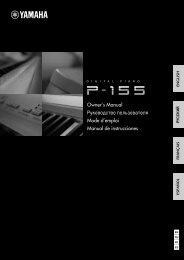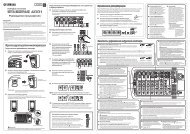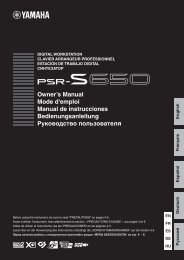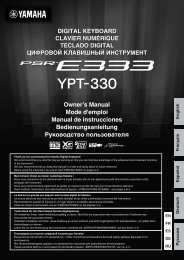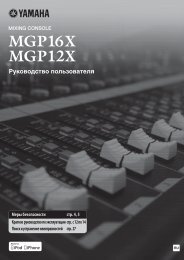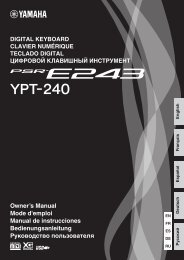Create successful ePaper yourself
Turn your PDF publications into a flip-book with our unique Google optimized e-Paper software.
Owner‘s <strong>Manual</strong><br />
EN
SPECIAL MESSAGE SECTION<br />
This product utilizes batteries or an external power<br />
supply (adapter). DO NOT connect this product to<br />
any power supply or adapter other than one<br />
described in the manual, on the name plate, or<br />
specifically recommended by Yamaha.<br />
WARNING: Do not place this product in a position<br />
where anyone could walk on, trip over ,or roll anything<br />
over power or connecting cords of any kind.<br />
The use of an extension cord is not recommended!<br />
If you must use an extension cord, the minimum<br />
wire size for a 25’ cord (or less ) is 18 AWG. NOTE:<br />
The smaller the AWG number ,the larger the current<br />
handling capacity. For longer extension cords,<br />
consult a local electrician.<br />
This product should be used only with the components<br />
supplied or; a cart, rack, or stand that is recommended<br />
by Yamaha. If a cart, etc., is used,<br />
please observe all safety markings and instructions<br />
that accompany the accessory product.<br />
SPECIFICATIONS SUBJECT TO CHANGE:<br />
The information contained in this manual is<br />
believed to be correct at the time of printing. However,<br />
Yamaha reserves the right to change or modify<br />
any of the specifications without notice or<br />
obligation to update existing units.<br />
This product, either alone or in combination with an<br />
amplifier and headphones or speaker/s, may be<br />
capable of producing sound levels that could cause<br />
permanent hearing loss. DO NOT operate for long<br />
periods of time at a high volume level or at a level<br />
that is uncomfortable. If you experience any hearing<br />
loss or ringing in the ears, you should consult<br />
an audiologist.<br />
IMPORTANT: The louder the sound, the shorter<br />
the time period before damage occurs.<br />
Some Yamaha products may have benches<br />
and / or accessory mounting fixtures that are<br />
either supplied with the product or as optional<br />
accessories. Some of these items are designed<br />
to be dealer assembled or installed. Please<br />
make sure that benches are stable and any<br />
optional fixtures (where applicable) are well<br />
secured BEFORE using.<br />
Benches supplied by Yamaha are designed for<br />
seating only. No other uses are recommended.<br />
NOTICE:<br />
Service charges incurred due to a lack of knowledge<br />
relating to how a function or effect works<br />
(when the unit is operating as designed) are not<br />
covered by the manufacturer’s warranty, and are<br />
therefore the owners responsibility. Please study<br />
this manual carefully and consult your dealer<br />
before requesting service.<br />
ENVIRONMENTAL ISSUES:<br />
Yamaha strives to produce products that are both<br />
user safe and environmentally friendly. We sincerely<br />
believe that our products and the production<br />
methods used to produce them, meet these goals.<br />
In keeping with both the letter and the spirit of the<br />
law, we want you to be aware of the following:<br />
Battery Notice:<br />
This product MAY contain a small non-rechargeable<br />
battery which (if applicable) is soldered in<br />
place. The average life span of this type of battery<br />
is approximately five years. When replacement<br />
becomes necessary, contact a qualified service<br />
representative to perform the replacement.<br />
This product may also use “household” type batteries.<br />
Some of these may be rechargeable. Make<br />
sure that the battery being charged is a rechargeable<br />
type and that the charger is intended for the<br />
battery being charged.<br />
When installing batteries, do not mix batteries with<br />
new, or with batteries of a different type. Batteries<br />
MUST be installed correctly. Mismatches or incorrect<br />
installation may result in overheating and battery<br />
case rupture.<br />
Warning:<br />
Do not attempt to disassemble, or incinerate any<br />
battery. Keep all batteries away from children. Dispose<br />
of used batteries promptly and as regulated<br />
by the laws in your area. Note: Check with any<br />
retailer of household type batteries in your area for<br />
battery disposal information.<br />
Disposal Notice:<br />
Should this product become damaged beyond<br />
repair, or for some reason its useful life is considered<br />
to be at an end, please observe all local,<br />
state, and federal regulations that relate to the disposal<br />
of products that contain lead, batteries, plastics,<br />
etc. If your dealer is unable to assist you,<br />
please contact Yamaha directly.<br />
NAME PLATE LOCATION:<br />
The name plate is located on the bottom of the<br />
product. The model number, serial number, power<br />
requirements, etc., are located on this plate. You<br />
should record the model number, serial number,<br />
and the date of purchase in the spaces provided<br />
below and retain this manual as a permanent<br />
record of your purchase.<br />
Model<br />
Serial No.<br />
Purchase Date<br />
PLEASE KEEP THIS MANUAL<br />
92-BP (bottom)
FCC INFORMATION (U.S.A.)<br />
1. IMPORTANT NOTICE: DO NOT MODIFY THIS<br />
UNIT!<br />
This product, when installed as indicated in the<br />
instructions contained in this manual, meets<br />
FCC requirements. Modifications not expressly<br />
approved by Yamaha may void your authority,<br />
granted by the FCC, to use the product.<br />
2. IMPORTANT: When connecting this product to<br />
accessories and/or another product use only<br />
high quality shielded cables. Cable/s supplied<br />
with this product MUST be used. Follow all<br />
installation instructions. Failure to follow instructions<br />
could void your FCC authorization to use<br />
this product in the USA.<br />
3. NOTE: This product has been tested and found<br />
to comply with the requirements listed in FCC<br />
Regulations, Part 15 for Class “B” digital<br />
devices. Compliance with these requirements<br />
provides a reasonable level of assurance that<br />
your use of this product in a residential environment<br />
will not result in harmful interference with<br />
other electronic devices. This equipment generates/uses<br />
radio frequencies and, if not installed<br />
and used according to the instructions found in<br />
the users manual, may cause interference<br />
harmful to the operation of other electronic<br />
devices. Compliance with FCC regulations does<br />
not guarantee that interference will not occur in<br />
all installations. If this product is found to be the<br />
source of interference, which can be determined<br />
by turning the unit “OFF” and “ON”,<br />
please try to eliminate the problem by using one<br />
of the following measures:<br />
Relocate either this product or the device that is<br />
being affected by the interference.<br />
Utilize power outlets that are on different branch<br />
(circuit breaker or fuse) circuits or install AC line<br />
filter/s.<br />
In the case of radio or TV interference, relocate/<br />
reorient the antenna. If the antenna lead-in is<br />
300 ohm ribbon lead, change the lead-in to coaxial<br />
type cable.<br />
If these corrective measures do not produce<br />
satisfactory results, please contact the local<br />
retailer authorized to distribute this type of product.<br />
If you can not locate the appropriate<br />
retailer, please contact Yamaha Corporation of<br />
America, Electronic Service Division, 6600<br />
Orangethorpe Ave, Buena Park, CA90620<br />
The above statements apply ONLY to those<br />
products distributed by Yamaha Corporation of<br />
America or its subsidiaries.<br />
* This applies only to products distributed by YAMAHA CORPORATION OF AMERICA. (class B)<br />
COMPLIANCE INFORMATION STATEMENT<br />
(DECLARATION OF CONFORMITY PROCEDURE)<br />
Responsible Party : Yamaha Corporation of America<br />
Address : 6600 Orangethorpe Ave., Buena Park, Calif. 90620<br />
Telephone : 714-522-9011<br />
Type of Equipment : MOBILE AUDIO INTERFACE<br />
Model Name : GO44<br />
This device complies with Part 15 of the FCC Rules.<br />
Operation is subject to the following conditions:<br />
1) this device may not cause harmful interference, and<br />
2) this device must accept any interference received including interference that<br />
may cause undesired operation.<br />
See user manual instructions if interference to radio reception is suspected.<br />
* This applies only to products distributed by<br />
YAMAHA CORPORATION OF AMERICA.<br />
(FCC DoC)
PRECAUTIONS<br />
PLEASE READ CAREFULLY BEFORE PROCEEDING<br />
* Please keep this manual in a safe place for future reference.<br />
WARNING<br />
Always follow the basic precautions listed below to avoid the possibility of serious injury or even<br />
death from electrical shock, short-circuiting, damages, fire or other hazards. These precautions<br />
include, but are not limited to, the following:<br />
Power supply/AC power adaptor<br />
• Only use the voltage specified as correct for the instrument.<br />
The required voltage is printed on the name plate of the<br />
instrument.<br />
• Use the specified adaptor (PA-3C or an equivalent<br />
recommended by Yamaha) only. Using the wrong adaptor can<br />
result in damage to the instrument or overheating.<br />
• Check the electric plug periodically and remove any dirt or dust<br />
which may have accumulated on it.<br />
• Do not place the AC adaptor cord near heat sources such as<br />
heaters or radiators, and do not excessively bend or otherwise<br />
damage the cord, place heavy objects on it, or place it in a<br />
position where anyone could walk on, trip over, or roll anything<br />
over it.<br />
Do not open<br />
• Do not open the instrument or attempt to disassemble the<br />
internal parts or modify them in any way. The instrument<br />
contains no user-serviceable parts. If it should appear to be<br />
malfunctioning, discontinue use immediately and have it<br />
inspected by qualified Yamaha service personnel.<br />
Water warning<br />
• Do not expose the instrument to rain, use it near water or in<br />
damp or wet conditions, or place containers on it containing<br />
liquids which might spill into any openings.<br />
• Never insert or remove an electric plug with wet hands.<br />
Fire warning<br />
• Do not put burning items, such as candles, on the unit.<br />
A burning item may fall over and cause a fire.<br />
If you notice any abnormality<br />
• If the AC adaptor cord or plug becomes frayed or damaged, or<br />
if there is a sudden loss of sound during use of the instrument,<br />
or if any unusual smells or smoke should appear to be caused<br />
by it, immediately disconnect the adaptor plug from the outlet,<br />
and have the instrument inspected by qualified Yamaha service<br />
personnel.<br />
CAUTION<br />
Always follow the basic precautions listed below to avoid the possibility of physical injury to you or<br />
others, or damage to the instrument or other property. These precautions include, but are not limited<br />
to, the following:<br />
Power supply/AC power adaptor<br />
• When removing the electric plug from the instrument or an<br />
outlet, always hold the plug itself and not the cord.<br />
• Unplug the AC power adaptor when not using the instrument,<br />
or during electrical storms.<br />
• Do not connect the instrument to an electrical outlet using a<br />
multiple-connector. Doing so can result in lower sound quality,<br />
or possibly cause overheating in the outlet.<br />
Location<br />
• Do not expose the instrument to excessive dust or vibrations,<br />
or extreme cold or heat (such as in direct sunlight, near a<br />
heater, or in a car during the day) to prevent the possibility of<br />
panel disfiguration or damage to the internal components.<br />
• Do not use the instrument in the vicinity of a TV, radio, stereo<br />
equipment, mobile phone, or other electric devices. Otherwise,<br />
the instrument, TV, or radio may generate noise.<br />
• Do not place the instrument in an unstable position where it<br />
might accidentally fall over.<br />
4<br />
(3)-9
• Before moving the instrument, remove all connected adaptor<br />
and other cables.<br />
• When setting up the instrument, make sure that the AC outlet you<br />
are using is easily accessible. If some trouble or malfunction<br />
occurs, immediately disconnect the plug from the outlet.<br />
Connections<br />
• Before connecting the instrument to other electronic<br />
components, turn off the power for all components. Before<br />
turning the power on or off for all components, set all volume<br />
levels to minimum. Also, be sure to set the volumes of all<br />
components at their minimum levels and gradually raise the<br />
volume controls while playing the instrument to set the desired<br />
listening level.<br />
Maintenance<br />
• When cleaning the instrument, use a soft, dry cloth. Do not use<br />
paint thinners, solvents, cleaning fluids, or chemicalimpregnated<br />
wiping cloths.<br />
Handling caution<br />
• Never insert or drop paper, metallic, or other objects into the<br />
gaps on the panel. If this happens, immediately unplug the<br />
power cord from the AC outlet. Then have the instrument<br />
inspected by qualified Yamaha service personnel.<br />
• Do not place vinyl, plastic or rubber objects on the instrument,<br />
since this might discolor the panel or keyboard.<br />
• Do not rest your weight on, or place heavy objects on the<br />
instrument, and do not use excessive force on the buttons,<br />
switches or connectors.<br />
• Do not use the instrument/device or headphones for a long<br />
period of time at a high or uncomfortable volume level, since<br />
this can cause permanent hearing loss. If you experience any<br />
hearing loss or ringing in the ears, consult a physician.<br />
Yamaha cannot be held responsible for damage caused by improper use or modifications to the instrument, or data that is lost or destroyed.<br />
SPECIAL NOTICES<br />
- This owner’s manual is the exclusive copyright of Yamaha Corporation.<br />
- The supplied Cubase LE, HALion SE, and Groove Agent SE are the exclusive copyrights of Steinberg Media<br />
Technologies GmbH.<br />
- Copying of the supplied software or reproduction of this manual in whole or in part by any means is expressly<br />
forbidden without the written consent of the manufacturer.<br />
- Yamaha makes no representations or warranties with regard to the use of the software and documentation<br />
and cannot be held responsible for the results of the use of this manual and the software.<br />
- The supplied disk is a CD-ROM. Do not attempt to play the disk on an audio CD player. Doing so may result<br />
in irreparable damage to your audio CD player.<br />
- Copying of the commercially available musical data including but not limited to MIDI data and/or audio data<br />
is strictly prohibited except for your personal use.<br />
- The screen displays as illustrated in this owner’s manual are for instructional purposes, and may appear<br />
somewhat different from the screens which appear on your computer.<br />
- Future upgrades of application and system software and any changes in specifications and functions will be<br />
announced separately.<br />
- Windows is the registered trademarks of Microsoft ® Corporation.<br />
- Apple and Macintosh are trademarks of Apple Computer, Inc., registered in the U.S. and other countries.<br />
- FireWire and the FireWire symbol are trademarks of Apple Computer, Inc., registered in the U.S. and other<br />
countries. The FireWire logo is a trademark of Apple Computer, Inc.<br />
- Steinberg, Cubase, HALion, and Groove Agent are the registered trademarks of Steinberg Media Technologies<br />
GmbH.<br />
- The company names and product names in this Owner’s <strong>Manual</strong> are the trademarks or registered trademarks<br />
of their respective companies.<br />
- Specifications and descriptions in this owner’s manual are for information purposes only.<br />
- Yamaha Corp. reserves the right to change or modify products or specifications at any time without prior<br />
notice. Since specifications, equipment or options may not be the same in every locale, please check with<br />
your Yamaha dealer.<br />
(3)-9<br />
5
Welcome to the GO44<br />
Thank you for choosing the Yamaha GO44 Mobile Audio Interface.<br />
The GO44 is a portable IEEE1394 (FireWire ® ) audio/MIDI interface featuring multi-channel<br />
operation and professional-quality audio. Connect the GO44 to a computer equipped with an<br />
IEEE1394 (FireWire) port and enjoy the powerful, versatile features of digital audio recording and<br />
editing.<br />
In order to take full advantage of the many features and capabilities provided by the GO44, we<br />
urge you to read this owner’s manual thoroughly before using your GO44 system, and keep the<br />
manual in a safe, accessible location for future reference.<br />
Table of contents<br />
Package Contents............................................................................................ 7<br />
About the Included Software.......................................................................... 7<br />
Power Supply................................................................................................... 7<br />
Software Installation — Windows users ......................................................... 8<br />
Compatible operating systems....................................................................... 8<br />
Preparing to Install......................................................................................... 8<br />
Installing the driver and the Control Panel ..................................................... 9<br />
Assigning the GO44 as the default system audio device (Windows) ............. 11<br />
Software Installation — Macintosh users ..................................................... 12<br />
Compatible operating systems..................................................................... 12<br />
Installing the Control Panel.......................................................................... 12<br />
Assigning the GO44 as the default system audio device (Mac OS X)............ 12<br />
Connectors and controls............................................................................... 13<br />
Front Panel .................................................................................................. 13<br />
Rear Panel.................................................................................................... 13<br />
I/O cable ..................................................................................................... 14<br />
Drivers ........................................................................................................... 16<br />
Windows drivers .......................................................................................... 16<br />
Mac OS X drivers ......................................................................................... 18<br />
GO44 Control Panel ...................................................................................... 19<br />
MAIN display ............................................................................................... 19<br />
The ASIO control panel (Windows only)....................................................... 21<br />
The SCENES panel ....................................................................................... 21<br />
ABOUT ........................................................................................................ 22<br />
Specifications................................................................................................. 23<br />
System Requirements.................................................................................... 24<br />
Troubleshooting............................................................................................ 25<br />
6
Package Contents<br />
The GO44 package contains the following<br />
items. Check the contents for missing items.<br />
• GO44 main unit<br />
• AC Power Adaptor (PA-3C) *<br />
• I/O cable<br />
• GO44 Owner’s <strong>Manual</strong><br />
• 2 CD-ROMs<br />
(Windows/Macintosh hybrid CD)<br />
• IEEE1394 (FireWire) cable<br />
(6–pin/6–pin)<br />
• IEEE1394 (FireWire) adaptor<br />
(4–pin/6–pin)<br />
* May not be included depending on your particular<br />
area. Please check with your Yamaha dealer.<br />
About the Included Software<br />
The included CD-ROMs contain the following<br />
software (driver).<br />
“TOOLS for GO44/GO46” CD-ROM<br />
• Driver/Control Panel installer (Windows)<br />
• Control Panel installer (Macintosh)<br />
• GO44 Owner’s <strong>Manual</strong> (PDF)<br />
• VST Instruments (VSTi)<br />
HALion SE (Windows/Macintosh)<br />
Groove Agent SE (Windows/Macintosh)<br />
“Cubase LE” CD-ROM<br />
• Cubase LE (Windows/Macintosh)<br />
NOTE<br />
• The serial number necessary for installing Cubase LE<br />
(Windows) is printed on a sheet included with the CD-<br />
ROM.<br />
• Please install Cubase LE while connected to the<br />
internet and enter all required items during installation.<br />
• For Macintosh computers double-click the “Cubase<br />
LE.pkg” icon.<br />
• To install VSTi, double-click the following file on the<br />
“TOOLS for GO44/GO46” CD-ROM.<br />
Windows: VSTi Set\Setup VSTi Set.exe<br />
Macintosh: VSTi Set\Setup VSTi Set.pkg<br />
Power Supply<br />
The GO44 does not have a power switch. The power is automatically turned on when the AC<br />
power adaptor is connected. The GO44 can also be powered via the 6–pin/6–pin IEEE1394<br />
(FireWire) port, making an AC power adaptor unnecessary. However, not all IEEE1394 (FireWire)<br />
controllers deliver a constant operating voltage — therefore, we recommend using the included<br />
AC power adaptor. The AC power adaptor is also useful whenever you would like to conserve the<br />
battery power of your laptop. The AC power adaptor is required if your computer only features a<br />
4–pin IEEE1394 (FireWire) port.<br />
7
Software Installation — Windows<br />
users<br />
NOTE<br />
Please perform the following steps in the given order. Do not connect the GO44 module to the<br />
computer until instructed to do so.<br />
Compatible operating systems<br />
The GO44 can be used only under Windows XP (Home/Professional editions) SP (Service Pack) 1<br />
and SP2. Other Windows versions are not supported. To check your Windows version, right click<br />
the [My Computer] icon and select [Properties] from the context menu. You can also access this<br />
menu item by clicking: [Start] → [Control Panel] → [System]. The Service Pack can be obtained<br />
free of charge from the Microsoft web site (www.microsoft.com).<br />
NOTE<br />
• Refer to the system requirements printed on the package, or in the PDF manual page 24. You can also<br />
check the latest system requirements on the Internet.<br />
http://www.yamahasynth.com/<br />
• If the [System] icon is not shown in the Control Panel, click “Switch to Classic View” in the upper left of the<br />
window to display all control panels and icons.<br />
Preparing to Install<br />
Select [Start] → [Control Panel] and go to [System] → [Hardware] → [Driver Signing] → [Driver<br />
Signing Options] and check the radio button to the left of “Ignore — Install the software anyway<br />
and don’t ask for my approval” and click [OK].<br />
NOTE<br />
After completing the installation, make sure to restore the original setting if necessary.<br />
8
Software Installation — Windows users<br />
Installing the driver and the Control Panel<br />
1. Insert the included “TOOLS for GO44/GO46” CD-ROM in the CD-ROM drive of<br />
your computer.<br />
2. Double-click on the CD-ROM drive icon in the My Computer menu. Open<br />
[GO44Driver_] → [GO44 Setup.exe] to start the InstallShield Wizard.<br />
3. Select a language for the setup wizard and click [Next] to continue with the installation.<br />
The welcome message of the InstallShield Wizard appears. Click [Next].<br />
4. If you want to specify a different location, click [Change]. Then click [Next].<br />
9
Software Installation — Windows users<br />
5. Click [Install] to start the installation.<br />
6. As soon as the message shown below appears, connect the GO44 to your computer’s<br />
IEEE1394 (FireWire) port using the included cable, and click [OK]. Windows<br />
XP will automatically recognize the device as new hardware and will open<br />
the driver installation dialog.<br />
7. Check the radio button to the left of “Yes, I want to restart my computer now.”<br />
and click [Finish] to restart the computer and complete the installation.<br />
10
Software Installation — Windows users<br />
8. Once the driver installation is complete, the GO44 should appear as the following<br />
entry in the Device Manager. The Device Manager can be found on the Control<br />
Panel under [System] → [Hardware]. Then click the [Device Manager] button.<br />
Assigning the GO44 as the default system audio<br />
device (Windows)<br />
If you would like to use the GO44 not only for specific audio applications, but as your default<br />
Windows audio device, go to the Control Panel, select [Sounds and Audio Devices] → [Audio]<br />
and specify the GO44 audio driver as the default device for the desired functions. Since the<br />
GO44 is a professional audio interface, the levels can only be adjusted using the included GO44<br />
Control Panel. The Windows mixer is disabled to prevent it from adversely affecting the signal<br />
quality.<br />
11
Software Installation — Macintosh<br />
users<br />
Compatible operating systems<br />
The GO44 can only be used under Mac OS 10.3.4 (OS X) or higher.<br />
NOTE Refer to the system requirements printed on the package, or in the PDF manual page 24. You can<br />
also check the latest system requirements on the Internet.<br />
http://www.yamahasynth.com/<br />
Installing the Control Panel<br />
The GO44 uses the operating system’s CoreAudio and CoreMIDI drivers. Therefore, it is not<br />
necessary to install a device-specific driver. Simply plug the device into your IEEE1394 (FireWire)<br />
port using the included cable and the GO44 can be used immediately. However, to take full<br />
advantage of the advanced routing, sample rate switching, and other control features, please<br />
install the included Control Panel.<br />
1. Insert the included “TOOLS for GO44/GO46” CD-ROM in the CD-ROM drive of<br />
your computer.<br />
2. Double-click on the CD-ROM drive icon and open [GO44Driver_] → [GO44<br />
Setup.pkg] to start the InstallShield Wizard.<br />
3. The welcome message of the InstallShield Wizard appears. Click [Continue].<br />
4. Select the hard disk drive where the Mac OS is installed as the destination for the<br />
installation. Click [Continue].<br />
5. Click [Install] to start the installation.<br />
6. Click [Restart] to complete the installation.<br />
NOTE<br />
For information about the Control Panel, see page 19 of the PDF manual.<br />
Assigning the GO44 as the default system audio<br />
device (Mac OS X)<br />
If you would like to use the GO44 not only for specific audio applications, but as your default<br />
Mac OS X audio device, select the GO44 audio driver in the [Sound] control panel as the default<br />
device for audio output.<br />
12
Connectors and controls<br />
Front Panel<br />
2<br />
1<br />
A PHONES jack<br />
Output for a 1/4" stereo headphone jack. This signal output applies not only to that of the<br />
OUTPUT 1/2 jacks (see Rear Panel), but also allows monitoring of other audio channels using<br />
the GO44 Control Panel. (See page 19.)<br />
B VOLUME control<br />
Adjusts the output level of the PHONES jack. Turn this control to the right to increase the level,<br />
and left to decrease it.<br />
Rear Panel<br />
3 4 5 6 7<br />
C DC IN jack<br />
Connects the AC power adaptor to this jack.<br />
D IEEE1394 (FireWire) port<br />
Connects the GO44 system to your computer using the included IEEE1394 (FireWire) cable.<br />
E MIDI / DIGITAL jack<br />
For connection of the included I/O cable (page 14), allowing input/output of digital audio<br />
and MIDI data.<br />
13
Connectors and controls<br />
F INPUT 1/2 jacks<br />
The GO44 System features two high-quality analog mono inputs. The connections have been<br />
designed for balanced/unbalanced phone 1/4" jacks. The input levels for these jacks can be<br />
selected from three different gain settings, HIGH, MID, and LOW. Refer to page 19 for details<br />
on how to make these settings.<br />
G OUTPUT 1/2 jacks<br />
The connections have been designed for balanced/unbalanced phone 1/4" jacks for main output.<br />
You can connect mixers, powered speakers, or amplifiers. The analog outputs operate<br />
with instrument-compatible levels of 2.0 Vrms.<br />
I/O cable<br />
8 9 J K<br />
H MIDI IN jack<br />
Connects MIDI devices such as MIDI keyboards and DAW controllers. For connecting MIDI<br />
devices, connect the MIDI OUT terminal of the MIDI device to this jack using a MIDI cable.<br />
I MIDI OUT jack<br />
Connects to MIDI devices such as synthesizers and tone generators. For connecting MIDI<br />
devices, connect the MIDI IN terminal of the MIDI device to this jack using a MIDI cable. This<br />
can also be used as a MIDI Thru terminal, for MIDI sequence software that allows routing of<br />
incoming MIDI data through the OUT jack, using a Thru (or MIDI Echo) function.<br />
J DIGITAL IN jack<br />
This coaxial type digital audio jack is for the digital input of audio signals. The interface can<br />
receive sample rates of up to 24-bit/96 kHz. The input signal can be adjusted in the Digital<br />
Mixer of the GO44 Control Panel. (See page 19.)<br />
14
Connectors and controls<br />
When recording from a digital source, make sure that the sampling rates of both devices (e.g.<br />
DAT recorder and laptop) are synchronized. The S/PDIF protocol contains a signal called<br />
wordclock for this purpose. If the Master Clock switch is set to “EXTERNAL” in the GO44 Control<br />
panel, the GO44 will automatically synchronize to it and the “DIGITAL IN” channel will be<br />
available in the mixer.<br />
ASIO applications such as Cubase often have an option to switch the hardware from an internal<br />
to an external (sometimes also called S/PDIF) clock source. This changeover currently has<br />
no effect on the GO44.<br />
NOTE Make sure to use RCA pin cables specially made for digital audio applications.<br />
K DIGITAL OUT jack<br />
This digital audio jack is for the digital output of audio signals. The interface can transmit sample<br />
rates of up to 24-bit/96 kHz. For playback, set the routing in the Control Panel to the digital<br />
output. AC3 and DTS can also be played back via the digital output. Select “NON AUDIO”<br />
for the digital output in the Control Panel under “ROUTING”. (See page 20.) The non-audio<br />
signals are not sent to the analog outputs.<br />
15
Drivers<br />
Windows drivers<br />
The GO44 audio interface features two kinds of audio drivers that support a variety of<br />
applications. The audio drivers support all bit rates between 8 and 24 bits with all common<br />
sample rates between 32 and 192 kHz. (Supports digital I/O up to 96 kHz)<br />
MME driver<br />
The Windows MME driver is a multi-channel driver that supports all channels of the GO44. The<br />
specific routing options for these drivers can be found in the GO44 Control Panel. In most<br />
Windows programs, you will encounter MME drivers with the designation “GO44(GO44 (1)) In<br />
1” for input channel and “GO44(GO44 (1)) MC Out” for output channel.<br />
ASIO driver<br />
ASIO (Audio Streaming Input Output) is an audio transfer protocol developed by Steinberg. The<br />
advantage of the ASIO driver is the extremely low audio recording and playback delay times, also<br />
known as latency. Values of around 5 ms on fast, cleanly configured systems — at sample rates<br />
exceeding 96 kHz — are quite realistic. The format also supports sound cards with multiple<br />
inputs and outputs — so-called multi-I/O cards, as well as direct monitoring and multi-client<br />
mode (ASIO 2.0 or later). In the programs that make use of Steinberg’s ASIO interface, the ASIO<br />
driver for the GO44 is listed as “ASIO GO4x.”<br />
Cubase LE<br />
16
Drivers<br />
For Cubase, the inputs are called “Line 1/2 left GO44”, “SPDIF left GO44”, etc. Also, the outputs<br />
(generally called “busses” or “channels”) available in the individual programs are generally called<br />
“Multichannel 1 GO44”, “SPDIF/AC3 left GO44”, etc.<br />
Cubase LE<br />
MIDI driver<br />
This driver is for using the GO44 MIDI IN and MIDI OUT ports. The driver is designated as<br />
“GO44(GO44 (1)) Midi In 1” (MIDI input) and “GO44(GO44 (1)) Midi Out 1” (MIDI output).<br />
NOTE<br />
MIDI files, which can be played back using Windows’ media players, are also to be transferred to<br />
externally connected devices such as synthesizers and tone generators. Open the “Sounds and<br />
Audio Devices Properties” window from the Windows Control Panel, go to “Audio” and set the<br />
“MIDI music playback” device to the driver mentioned above.<br />
17
Drivers<br />
Mac OS X drivers<br />
In Mac OS X, the GO44 system is supported completely by Apple CoreAudio and CoreMIDI.<br />
Device-specific drivers are not required. If you would like to use the GO44 for the default system<br />
sound output, select the GO44 audio driver in [System Preferences] → [Sound] → [Output].<br />
The CoreAudio/MIDI driver can also be selected in DAW applications such as Cubase. Buffer sizes<br />
generally can also be configured there to accelerate access to the audio system.<br />
Cubase LE<br />
18
GO44 Control Panel<br />
The GO44 Control Panel is quite intuitive and should not present beginners with major problems.<br />
Here, depending on the requirements of each situation, you can have total control of the audio<br />
interface, reduce levels, route inputs to any output or set the Master Clock values.<br />
NOTE The functions and the positions of the control elements are generally identical between the two<br />
platforms, Windows and Mac OS. The following example illustrations have been taken from the<br />
Windows version of the Control Panel.<br />
MAIN display<br />
In the MAIN display, you can control the digital mixer of the GO44, set sample rates, route any<br />
input to any output, etc.<br />
NOTE<br />
If you are working with common DAW applications, you should also use the DAW for level control.<br />
The advantage for doing this is that the settings are usually saved together with your project (song,<br />
arrangement etc.)<br />
ANALOG IN / DIGITAL IN<br />
Here you can control the levels of analog input channels in the ANALOG IN column and digital<br />
input channels in the DIGITAL IN column. Use the faders to control the levels of corresponding<br />
channels. The [MUTE] buttons can be used to mute the individual channels.<br />
In the ANALOG IN column, you can set the gain levels of the INPUT 1/2 jacks. Click the pulldown<br />
menu at the top of the ANALOG IN column and select from among the settings “LOW”,<br />
“MID”, and “HIGH” for the input channels. Select “HIGH” to connect low-level equipment such<br />
as microphones, and “LOW” to connect high, line-level equipment such as keyboards.<br />
A separate fader is available for each mono channel. The individual channels can be joined using<br />
the switchable stereo link function. To turn on/off the stereo link function, click the [PAIR] button.<br />
While the stereo link function is active, faders and mute operations are linked.<br />
DIGITAL IN is grayed out until a signal is applied to the digital input and the MASTER CLOCK<br />
(page 20) is set to [EXTERNAL].<br />
19
GO44 Control Panel<br />
DAW IN 1/2, 3/4, 5/6<br />
Here you can adjust the levels of the output signals sent from DAW applications.<br />
As with the ANALOG IN / DIGITAL IN, a separate fader is available for each mono channel. The<br />
individual channels can be joined using the switchable stereo link function (the [PAIR] button).<br />
While the stereo link function is active, faders and mute operations are linked.<br />
To send the mixed signal, [DIGITAL MIXER] must be assigned in the ROUTING section. If<br />
[DIGITAL MIXER] is not assigned for any outputs, the operation of the digital mixer is ignored.<br />
MASTER<br />
The overall playback level of the digital mixer can be set with the Master control. In Windows,<br />
faders and mute operations can be linked using the stereo link function.<br />
MASTER CLOCK<br />
This controls the sample rate used by the GO44. When digital inputs are not used, click the<br />
[INTERNAL] button and choose from all commonly used sample rates from 32 to 192 kHz from<br />
the pull-down menu.<br />
When external devices such as DAT recorders are connected, click the [EXTERNAL] button. The<br />
external sample rate is displayed in the box next to the [EXTERNAL] button. If no signal is<br />
available or the connection has been interrupted, the message “--------” will be returned.<br />
NOTE<br />
• When a sample rate of 192kHz is selected, only the ANALOG IN (for audio inputs) and DAW IN 1/2 (for<br />
audio outputs) columns are available.<br />
• When a sample rate of 192kHz is selected, avoid using MIDI inputs and outputs since this may cause some<br />
noise and glitches in the sound.<br />
ROUTING<br />
Selects the output signal sent from the OUTPUT 1/2, PHONES, and DIGITAL OUT jacks. All input<br />
signals (DAW IN 1/2, DAW IN 3/4, DAW IN 5/6, ANALOG IN, DIGITAL IN, and DIGITAL MIXER)<br />
can be routed to the three output pairs*. Click the three buttons on the left-hand side to open a<br />
pull-down menu from which you can select the desired pair. If you intend to use the digital<br />
mixer, [DIGITAL MIXER] must also be selected on the input side, otherwise the signal will be sent<br />
straight to the output, bypassing the faders.<br />
* For the DIGITAL OUT jack, you can select<br />
“NON AUDIO” (as shown above). In this case,<br />
AC3 and DTS data will be transmitted only via<br />
the digital output.<br />
SETTINGS<br />
Calls up the ASIO control panel (for ASIO driver settings), the SCENES panel for saving the GO44<br />
Control Panel settings, and the ABOUT display for system related information.<br />
20
GO44 Control Panel<br />
The ASIO control panel (Windows only)<br />
Selects a latency value (delay in playing the audio signals) when using the ASIO driver. To open<br />
the ASIO panel, click the [ASIO] button in the SETTINGS column of the MAIN display.<br />
If the value is too low (and the sample rate too high), this will negatively affect the performance<br />
of your overall system, introducing noise and dropouts. A more powerful computer will support a<br />
lower latency setting. With a fast system, you should achieve values of less than 5ms at 96kHz. If<br />
problems occur, increase the latency as needed.<br />
Further options are generally available on the relevant panels of ASIO applications such as<br />
Cubase, etc.<br />
The SCENES panel<br />
Saves/calls up scenes. A scene is a file in which the Control Panel settings are saved (except<br />
settings in the MASTER CLOCK column; page 20). Save the scene and call up the file, and the<br />
settings can be reloaded whenever necessary. To open the SCENES panel in Windows, click the<br />
[SCENES] button in the SETTINGS column of the MAIN display; on the Macintosh, select [File] →<br />
[SCENES] from the GO44 menu.<br />
To save a scene, input a name for the scene in the box located to the left of the [SAVE] button<br />
and click the [SAVE] button. To load or delete a saved scene, select the desired scene name from<br />
the box and click the [LOAD] or [DELETE] button.<br />
21
GO44 Control Panel<br />
ABOUT<br />
The ABOUT display of the GO44 Control Panel gives you all of the relevant facts on your Control<br />
Panel, audio drivers, firmware version, and operating system. To open the ABOUT display in<br />
Windows, click the [ABOUT] button in the SETTINGS column of the MAIN display.<br />
NOTE On the Macintosh, if you place the mouse pointer over the YAMAHA logo of the MAIN display, information<br />
about your Control Panel, etc. is shown in the bottom of the display.<br />
22
Specifications<br />
■ General Specifications<br />
Bit Depth 8/16/24<br />
Sampling Frequency (kHz) 32/44.1/48/88.2/96/192<br />
Frequency Response<br />
Dynamic Range<br />
Power Consumption<br />
20Hz — 20kHz<br />
109dB (Input (Mid) @ 44.1kHz)<br />
6W<br />
■ Input/Output Specifications<br />
Analog Input<br />
Connector<br />
Nominal Input<br />
Level<br />
Resolution<br />
-3dBu (Low)<br />
INPUT 1/2<br />
TRS Phone (Balanced)<br />
+4dBu (Mid)<br />
24bit ADC, up to 192kHz<br />
+8dBu (High)<br />
Analog Output<br />
Connector<br />
Nominal<br />
Output Level<br />
Max. Output<br />
Level<br />
Resolution<br />
OUTPUT 1/2 TRS Phone (Balanced) +4dBu +8dBu<br />
PHONES TRS Phone (Stereo) — +16dBu<br />
24bit DAC<br />
up to 192kHz<br />
24bit DAC<br />
up to 192kHz<br />
Digital Input/<br />
Output<br />
Connector Format Resolution Other details<br />
DIGITAL IN<br />
DIGITAL OUT<br />
IEEE1394<br />
(FireWire)<br />
RCA Pin (Coaxial)<br />
RCA Pin (Coaxial)<br />
IEC60958<br />
Consumer use<br />
IEC60958<br />
Consumer use<br />
24bit, up to<br />
96kHz<br />
24bit, up to<br />
96kHz<br />
IEEE1394 6Pin IEEE1394 —<br />
—<br />
AC3 and DTS<br />
Pass Through<br />
6INPUT/4OUTPUT<br />
Channel (To PC)<br />
MIDI IN/OUT 5pin DIN MIDI — —<br />
23
System Requirements<br />
GO44<br />
NOTE<br />
• The system requirements below may differ slightly<br />
depending on the particular operating system.<br />
• For details on minimum requirements for each DAW<br />
(Digital Audio Workstation) software, refer to the<br />
respective owner’s manual.<br />
• You can check the latest system requirements on the<br />
Internet.<br />
http://www.yamahasynth.com/<br />
Windows<br />
OS<br />
CPU<br />
Available<br />
Memory<br />
Windows XP Professional/Home Edition<br />
(SP1 or SP2)<br />
Pentium III 800MHz or higher<br />
(Pentium 4 2GHz or higher recommended)<br />
256MB or more<br />
(512MB or more recommended)<br />
IEEE1394 (FireWire) terminal*<br />
* The computer must have an IEEE 1394 (FireWire)<br />
terminal. If there is no terminal, install an IEEE 1394<br />
interface card (PCI or PCMCIA).<br />
CUBASE LE<br />
Windows<br />
OS<br />
CPU<br />
Available<br />
Memory<br />
Hard<br />
Disk<br />
Macintosh<br />
OS<br />
CPU<br />
Available<br />
Memory<br />
Hard Disk<br />
Windows 2000/Windows XP<br />
Professional/Home Edition<br />
Pentium III 500MHz or higher<br />
(Pentium III 1GHz or higher<br />
recommended)<br />
256MB or more<br />
(512MB or more recommended)<br />
1GB or more<br />
Mac OS X 10.3.3 or later<br />
G4 450MHz or higher<br />
256MB or more<br />
(512MB or more recommended)<br />
1GB or more<br />
HALion SE/Groove Agent SE<br />
Macintosh<br />
OS<br />
CPU<br />
Available<br />
Memory<br />
Mac OS X 10.3.4 or later<br />
G4 800MHz or higher<br />
(G5 1.8GHz or higher recommended)<br />
256MB or more<br />
(512MB or more recommended)<br />
Windows<br />
OS<br />
CPU<br />
Available<br />
Memory<br />
Hard Disk<br />
Macintosh<br />
OS<br />
CPU<br />
Available<br />
Memory<br />
Hard Disk<br />
Windows XP Professional/Home Edition<br />
Pentium III 800MHz or higher<br />
(Pentium 4 2.8GHz or higher<br />
recommended)<br />
384MB or more<br />
(512MB or more recommended)<br />
512MB or more<br />
Mac OS X 10.3 or later<br />
G4 867MHz or higher<br />
(G5 Dual 1.8GHz or higher<br />
recommended)<br />
384MB or more<br />
(512MB or more recommended)<br />
512MB or more<br />
24
Troubleshooting<br />
■ The GO44 won’t turn on.<br />
•<br />
Is the supplied power adaptor properly plugged into both the GO44 and an appropriate AC<br />
wall outlet?<br />
•<br />
If you are using a 4–pin/6–pin IEEE1394 (FireWire) adaptor to connect the GO44 to the computer<br />
with a 4–pin type IEEE1394 (FireWire) port, use the included AC power adaptor. (See<br />
page 7.)<br />
■ The system doesn’t work properly.<br />
•<br />
Are you using an IEEE1394 (FireWire) Repeater?<br />
IEEE1394 (FireWire) Repeater hubs can interfere with proper operation, so try connecting the<br />
GO44 directly to an IEEE1394 (FireWire) port on the computer. If the computer has multiple<br />
IEEE1394 (FireWire) ports, try a different port.<br />
•<br />
If you are using other IEEE1394 (FireWire) devices at the same time, try removing the other<br />
device(s) and connecting only the Yamaha IEEE1394 (FireWire) device.<br />
•<br />
Does your computer satisfy the system requirements? (See page 24.)<br />
•<br />
(For Windows) Install the driver again.<br />
■ (For Windows) Cannot install the driver.<br />
•<br />
Does your computer satisfy the system requirements? (See page 24.)<br />
•<br />
Install the driver again.<br />
■ (For Windows) The “Found New Hardware Wizard” window is displayed.<br />
•<br />
Is the driver installed? (See page 8.)<br />
•<br />
Cancel the Wizard and install the driver again.<br />
■ No sound or very low volume level<br />
•<br />
Are speakers or headphones connected correctly?<br />
•<br />
Is your amp and other external devices turned on?<br />
•<br />
Is the signal from the external device being input?<br />
•<br />
Are all the level settings (of any tone generators, audio devices, application software, computer<br />
operating system, etc.) appropriate?<br />
•<br />
Are the output channels muted in the OS (computer) or the GO44 Control Panel?<br />
•<br />
The connection cable from the external device may be broken.<br />
•<br />
Is the wordclock setting correct for both the GO44 and the external device(s)? (See page 20.)<br />
•<br />
Is the output jack for the audio data assigned in the DAW software (Cubase LE, etc.)?<br />
For details, refer to the respective owner’s manual.<br />
•<br />
Try disconnecting the IEEE1394 (FireWire) cable and after a while connect it again.<br />
■ Distorted sound<br />
•<br />
Does your computer satisfy the system requirements? (See page 24.)<br />
•<br />
Is the gain level set correctly in the GO44 Control Panel? (See page 19.)<br />
•<br />
The connection cable from the external device may be broken.<br />
•<br />
Is the wordclock setting correct for both the GO44 and the external device(s)? (See page 20.)<br />
•<br />
Make sure audio data was recorded at an appropriate level.<br />
25
Troubleshooting<br />
■ Noise is audible.<br />
•<br />
(For Windows) Is the latency setting of the ASIO Driver appropriate? (See page 21.)<br />
•<br />
(For Windows) When using Cubase LE with a computer which the Hyper Threading is on, set as<br />
follows on Cubase LE.<br />
Select [Devices] → [Device Setup] → [VST Multitrack] → [Expert] and check the box to the left<br />
of “Multi Processing” and click [OK].<br />
•<br />
(For Windows) Setting Hyper Threading to off in the BIOS settings may solve the problem.<br />
•<br />
Is the wordclock setting correct for both the GO44 and the external device(s)? (See page 20.)<br />
•<br />
If the speed of your computer’s hard disk is slow, problems may occur during recording and<br />
playback.<br />
•<br />
If you connect/disconnect the LAN, USB or the cables to the mini jacks terminals you are using<br />
while recording/playback, some noise may be caused and/or data may be cut off. Make sure<br />
that you do not insert or unplug any connections while recording/playback.<br />
•<br />
Is the sample rate (wordclock) appropriate? A high sample rate can be the cause of the noise<br />
depending on the computer capacity and speed. (See page 20.)<br />
•<br />
Use of MIDI inputs and outputs when the sample rate is set to 192kHz may cause some noise<br />
and glitches in the sound. Do not use MIDI inputs and outputs when the sample rate is set to<br />
192 kHz.<br />
•<br />
Try disconnecting the IEEE1394 (FireWire) cable and after a while connect it again.<br />
■ Cannot resume or suspend the computer correctly.<br />
•<br />
To protect the data you are working on, the computer prevents resuming or suspending the<br />
computer while the DAW applications/ sequencer software is active. Close the application to<br />
resume or suspend your computer.<br />
26
For details of products, please contact your nearest Yamaha<br />
representative or the authorized distributor listed below.<br />
Pour plus de détails sur les produits, veuillez-vous adresser à<br />
Yamaha ou au distributeur le plus proche de vous figurant dans<br />
la liste suivante.<br />
Die Einzelheiten zu Produkten sind bei Ihrer unten aufgeführten<br />
Niederlassung und bei Yamaha Vertragshändlern in<br />
den jeweiligen Bestimmungsländern erhältlich.<br />
Para detalles sobre productos, contacte su tienda Yamaha más<br />
cercana o el distribuidor autorizado que se lista debajo.<br />
<br />
<br />
NORTH AMERICA<br />
CANADA<br />
Yamaha Canada Music Ltd.<br />
135 Milner Avenue, Scarborough, Ontario,<br />
M1S 3R1, Canada<br />
Tel: 416-298-1311<br />
U.S.A.<br />
Yamaha Corporation of America<br />
6600 Orangethorpe Ave., Buena Park, Calif.<br />
90620, U.S.A.<br />
Tel: 714-522-9011<br />
CENTRAL & SOUTH AMERICA<br />
MEXICO<br />
Yamaha de México S.A. de C.V.<br />
Calz. Javier Rojo Gómez #1149,<br />
Col. Guadalupe del Moral<br />
C.P. 09300, México, D.F., México<br />
Tel: 55-5804-0600<br />
BRAZIL<br />
Yamaha Musical do Brasil Ltda.<br />
Av. Reboucas 2636-Pinheiros CEP: 05402-400<br />
Sao Paulo-SP. Brasil<br />
Tel: 011-3085-1377<br />
ARGENTINA<br />
Yamaha Music Latin America, S.A.<br />
Sucursal de Argentina<br />
Viamonte 1145 Piso2-B 1053,<br />
Buenos Aires, Argentina<br />
Tel: 1-4371-7021<br />
PANAMA AND OTHER LATIN<br />
AMERICAN COUNTRIES/<br />
CARIBBEAN COUNTRIES<br />
Yamaha Music Latin America, S.A.<br />
Torre Banco General, Piso 7, Urbanización Marbella,<br />
Calle 47 y Aquilino de la Guardia,<br />
Ciudad de Panamá, Panamá<br />
Tel: +507-269-5311<br />
EUROPE<br />
THE UNITED KINGDOM<br />
Yamaha-Kemble Music (U.K.) Ltd.<br />
Sherbourne Drive, Tilbrook, Milton Keynes,<br />
MK7 8BL, England<br />
Tel: 01908-366700<br />
IRELAND<br />
Danfay Ltd.<br />
61D, Sallynoggin Road, Dun Laoghaire, Co. Dublin<br />
Tel: 01-2859177<br />
GERMANY<br />
Yamaha Music Central Europe GmbH<br />
Siemensstraße 22-34, 25462 Rellingen, Germany<br />
Tel: 04101-3030<br />
SWITZERLAND/LIECHTENSTEIN<br />
Yamaha Music Central Europe GmbH,<br />
Branch Switzerland<br />
Seefeldstrasse 94, 8008 Zürich, Switzerland<br />
Tel: 01-383 3990<br />
AUSTRIA<br />
Yamaha Music Central Europe GmbH,<br />
Branch Austria<br />
Schleiergasse 20, A-1100 Wien, Austria<br />
Tel: 01-60203900<br />
CZECH REPUBLIC/SLOVAKIA/<br />
HUNGARY/SLOVENIA<br />
Yamaha Music Central Europe GmbH,<br />
Branch Austria, CEE Department<br />
Schleiergasse 20, A-1100 Wien, Austria<br />
Tel: 01-602039025<br />
POLAND<br />
Yamaha Music Central Europe GmbH<br />
Sp.z. o.o. Oddzial w Polsce<br />
ul. 17 Stycznia 56, PL-02-146 Warszawa, Poland<br />
Tel: 022-868-07-57<br />
THE NETHERLANDS/<br />
BELGIUM/LUXEMBOURG<br />
Yamaha Music Central Europe GmbH,<br />
Branch Benelux<br />
Clarissenhof 5-b, 4133 AB Vianen, The Netherlands<br />
Tel: 0347-358 040<br />
FRANCE<br />
Yamaha Musique France<br />
BP 70-77312 Marne-la-Vallée Cedex 2, France<br />
Tel: 01-64-61-4000<br />
ITALY<br />
Yamaha Musica Italia S.P.A.<br />
Combo Division<br />
Viale Italia 88, 20020 Lainate (Milano), Italy<br />
Tel: 02-935-771<br />
SPAIN/PORTUGAL<br />
Yamaha-Hazen Música, S.A.<br />
Ctra. de la Coruna km. 17, 200, 28230<br />
Las Rozas (Madrid), Spain<br />
Tel: 91-639-8888<br />
GREECE<br />
Philippos Nakas S.A. The Music House<br />
147 Skiathou Street, 112-55 Athens, Greece<br />
Tel: 01-228 2160<br />
SWEDEN<br />
Yamaha Scandinavia AB<br />
J. A. Wettergrens Gata 1<br />
Box 30053<br />
S-400 43 Göteborg, Sweden<br />
Tel: 031 89 34 00<br />
DENMARK<br />
YS Copenhagen Liaison Office<br />
Generatorvej 6A<br />
DK-2730 Herlev, Denmark<br />
Tel: 44 92 49 00<br />
FINLAND<br />
F-Musiikki Oy<br />
Kluuvikatu 6, P.O. Box 260,<br />
SF-00101 Helsinki, Finland<br />
Tel: 09 618511<br />
NORWAY<br />
Norsk filial av Yamaha Scandinavia AB<br />
Grini Næringspark 1<br />
N-1345 Østerås, Norway<br />
Tel: 67 16 77 70<br />
ICELAND<br />
Skifan HF<br />
Skeifan 17 P.O. Box 8120<br />
IS-128 Reykjavik, Iceland<br />
Tel: 525 5000<br />
OTHER EUROPEAN COUNTRIES<br />
Yamaha Music Central Europe GmbH<br />
Siemensstraße 22-34, 25462 Rellingen, Germany<br />
Tel: +49-4101-3030<br />
AFRICA<br />
Yamaha Corporation,<br />
Asia-Pacific Music Marketing Group<br />
Nakazawa-cho 10-1, Hamamatsu, Japan 430-<br />
8650<br />
Tel: +81-53-460-2312<br />
MIDDLE EAST<br />
TURKEY/CYPRUS<br />
Yamaha Music Central Europe GmbH<br />
Siemensstraße 22-34, 25462 Rellingen, Germany<br />
Tel: 04101-3030<br />
OTHER COUNTRIES<br />
Yamaha Music Gulf FZE<br />
LB21-128 Jebel Ali Freezone<br />
P.O.Box 17328, Dubai, U.A.E.<br />
Tel: +971-4-881-5868<br />
ASIA<br />
THE PEOPLE’S REPUBLIC OF<br />
CHINA<br />
Yamaha Music & Electronics (China)<br />
Co.,Ltd.<br />
25/F., United Plaza, 1468 Nanjing Road (West),<br />
Jingan, Shanghai, China<br />
Tel: 021-6247-2211<br />
HONG KONG<br />
Tom Lee Music Co., Ltd.<br />
11/F., Silvercord Tower 1, 30 Canton Road,<br />
Tsimshatsui, Kowloon, Hong Kong<br />
Tel: 2737-7688<br />
INDONESIA<br />
PT. Yamaha Music Indonesia (Distributor)<br />
PT. Nusantik<br />
Gedung Yamaha Music Center, Jalan Jend.<br />
Gatot Subroto Kav. 4, Jakarta 12930, Indonesia<br />
Tel: 21-520-2577<br />
KOREA<br />
Yamaha Music Korea Ltd.<br />
Tong-Yang Securities Bldg. 16F 23-8 Yoidodong,<br />
Youngdungpo-ku, Seoul, Korea<br />
Tel: 02-3770-0660<br />
MALAYSIA<br />
Yamaha Music Malaysia, Sdn., Bhd.<br />
Lot 8, Jalan Perbandaran, 47301 Kelana Jaya,<br />
Petaling Jaya, Selangor, Malaysia<br />
Tel: 3-78030900<br />
PHILIPPINES<br />
Yupangco Music Corporation<br />
339 Gil J. Puyat Avenue, P.O. Box 885 MCPO,<br />
Makati, Metro Manila, Philippines<br />
Tel: 819-7551<br />
SINGAPORE<br />
Yamaha Music Asia Pte., Ltd.<br />
#03-11 A-Z Building<br />
140 Paya Lebor Road, Singapore 409015<br />
Tel: 747-4374<br />
TAIWAN<br />
Yamaha KHS Music Co., Ltd.<br />
3F, #6, Sec.2, Nan Jing E. Rd. Taipei.<br />
Taiwan 104, R.O.C.<br />
Tel: 02-2511-8688<br />
THAILAND<br />
Siam Music Yamaha Co., Ltd.<br />
891/1 Siam Motors Building, 15-16 floor<br />
Rama 1 road, Wangmai, Pathumwan<br />
Bangkok 10330, Thailand<br />
Tel: 02-215-2626<br />
OTHER ASIAN COUNTRIES<br />
Yamaha Corporation,<br />
Asia-Pacific Music Marketing Group<br />
Nakazawa-cho 10-1, Hamamatsu, Japan 430-<br />
8650<br />
Tel: +81-53-460-2317<br />
OCEANIA<br />
AUSTRALIA<br />
Yamaha Music Australia Pty. Ltd.<br />
Level 1, 99 Queensbridge Street, Southbank,<br />
Victoria 3006, Australia<br />
Tel: 3-9693-5111<br />
NEW ZEALAND<br />
Music Houses of N.Z. Ltd.<br />
146/148 Captain Springs Road, Te Papapa,<br />
Auckland, New Zealand<br />
Tel: 9-634-0099<br />
COUNTRIES AND TRUST<br />
TERRITORIES IN PACIFIC OCEAN<br />
Yamaha Corporation,<br />
Asia-Pacific Music Marketing Group<br />
Nakazawa-cho 10-1, Hamamatsu, Japan 430-<br />
8650<br />
Tel: +81-53-460-2312<br />
SY37<br />
HEAD OFFICE<br />
Yamaha Corporation, Pro Audio & Digital Musical Instrument<br />
Division<br />
Nakazawa-cho 10-1, Hamamatsu, Japan 430-8650<br />
Tel: +81-53-460-2445
Yamaha Web Site (English Only)<br />
http://www.yamahasynth.com<br />
Yamaha <strong>Manual</strong> Library<br />
http://www.yamaha.co.jp/manual/<br />
U.R.G., Pro Audio & Digital Musical Instrument Division, Yamaha Corporation<br />
© 2006 Yamaha Corporation


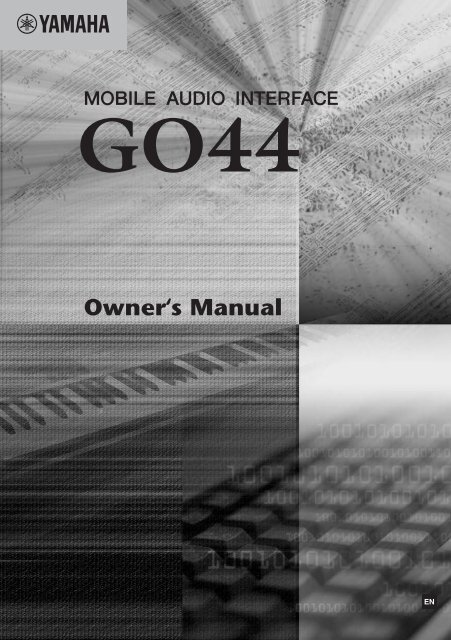

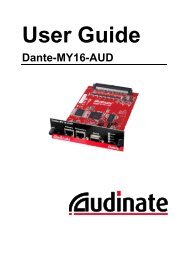

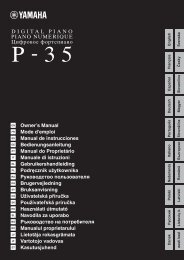
![СкаÑаÑÑ ÑÑÑÑкÑÑ Ð¸Ð½ÑÑÑÑкÑÐ¸Ñ Yamaha DGX-650WH PDF [12MB]](https://img.yumpu.com/44529686/1/184x260/nnn-nnnnnn-1-2-nnnnnn-yamaha-dgx-650wh-pdf-12mb.jpg?quality=85)

